The Independent's journalism is supported by our readers. When you purchase through links on our site, we may earn commission.
From kangaroo salad to garlic ‘bugs’: Exploring Australia’s 50,000-year-old culinary history
As an island with Indigenous people and a global array of immigrants, Australia’s food culture is ripe for exploration. A new book does just that, writes Hannah Twiggs


What comes to mind when you think of authentic Australian food? I’ll hazard a guess and assume it’s not kangaroo sausages, food wrapped in paperbark and smoked over hot coals, or bread using flour made from ground seeds and nuts, which the Aboriginal Australians were cooking long before the colonists arrived.
If you know your stuff, you might have mentioned damper bread brought in by Irish convicts in the 1820s, curries that started filtering in from India in the early 1800s, roast goose or lamb from British immigrants craving a taste of home, the phenomenon of the Australian-Chinese restaurant, or the Aussies’ more recent obsessions with Italian and Greek.
But let’s face it, your first thought was probably “shrimps on the barbie” and Vegemite.
Well, you wouldn’t technically be wrong. Ross Dobson’s new book Australia: The Cookbook, which explores Australian cuisine’s complex history and myriad influences over 50,000 years, includes all of the above.
Read more:
It’s a veritable tome of a cookbook – nay, an encyclopaedia – that could have you sat for hours exploring the country’s fascinatingly varied, yet singular, culinary landscape with both lightheartedness and sensitivity.
If you do manage to tear yourself away from the chunky, 22-page history section (not to mention the fascinating essay on Aboriginal bushfood), there’s then the task of choosing something to eat from the more than 350 recipes, ranging from Australian icons and twists on classics, to controversial inclusions (ahem, avocado on toast) and lesser known specialities.
So yes, slipping some shrimps on the barbie, sitting back and having a read of this ambitious volume might be the easier option, but unfortunately you won’t find that recipe here. You will, however, find six others that are as mouth-watering as they are unusual.
Note: we don’t recommend nicking a kangaroo from a zoo, so you might need to find an alternative lean meat for one of these recipes.
Spinach and cheese cob
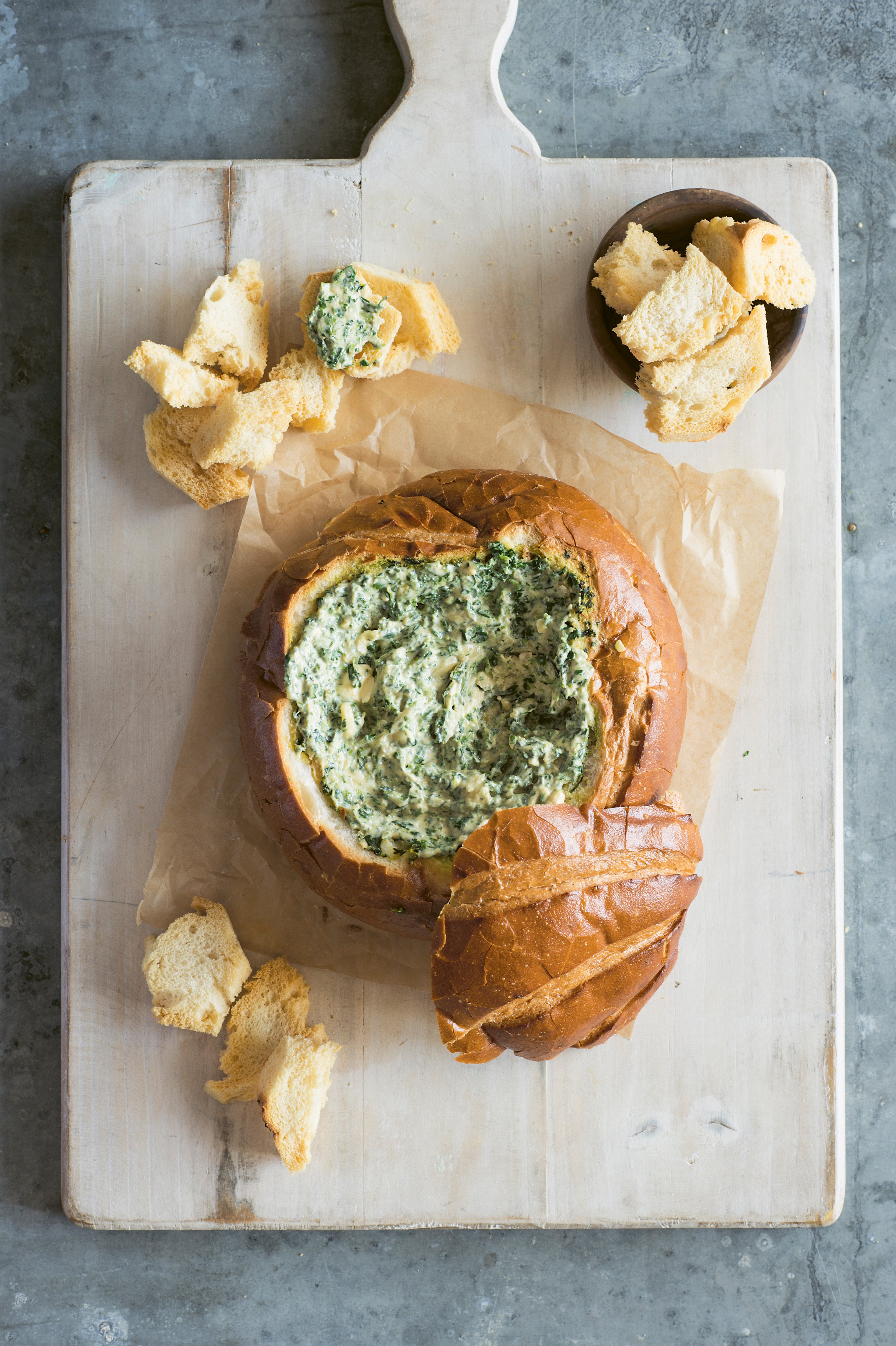
A cob loaf is a perfectly fine, round soft loaf of bread, and like many other things, it came to Australia from the UK. But Australians like to take things one step further by stuffing the cob. That’s right. The loaf is stuffed. The top is cut off and the soft bread inside is removed and cut into finger food-size pieces. The cob can be warmed, depending how fresh it is and then stuffed. The most common stuffing is spinach and cheese. The cob loaf World Champion is announced at the annual Cob Loaf Festival in the western New South Wales town of Wellington. At this festival, the cob is stuffed with a veritable cornucopia of foods: anything from crab and bacon to rocky road and Nutella. In Australia, the cob is a blank canvas.
Preparation time: 20 minutes
Cooking time: 30 minutes
Serves: 8-10 to share
Ingredients
1 x 500g cob loaf
250g frozen spinach
2 spring onions, finely sliced
250g cream cheese
160ml sour cream
160ml single (light) cream
100g cheddar cheese, coarsely grated
100g mozzarella cheese, coarsely grated
40g package French onion soup mix
Method
Preheat the oven to 180C/350F/Gas Mark 4.
Line a baking tray with baking paper.
Cut about 5cm off the top of the loaf and set aside. Use your hands to pull out most of the bread from inside the loaf, cut it into bite-size pieces and set aside. Put the spinach into a colander to thaw and drain. When soft, squeeze out as much water as possible.
Tip the spinach into a large bowl, add the remaining ingredients and stir until combined. Place the hollowed-out cob onto the prepared sheet, pour in the spinach mixture, put the bread top on and bake for 20 minutes until the loaf is golden and crisp. Remove and set aside.
Sprinkle the reserved pieces of bread on a separate baking sheet. Bake for 8-10 minutes until golden. Transfer the cob to a serving plate, remove the bread lid and use the toasted bread pieces to dip into the gooey, hot cheese.
Thai kangaroo salad
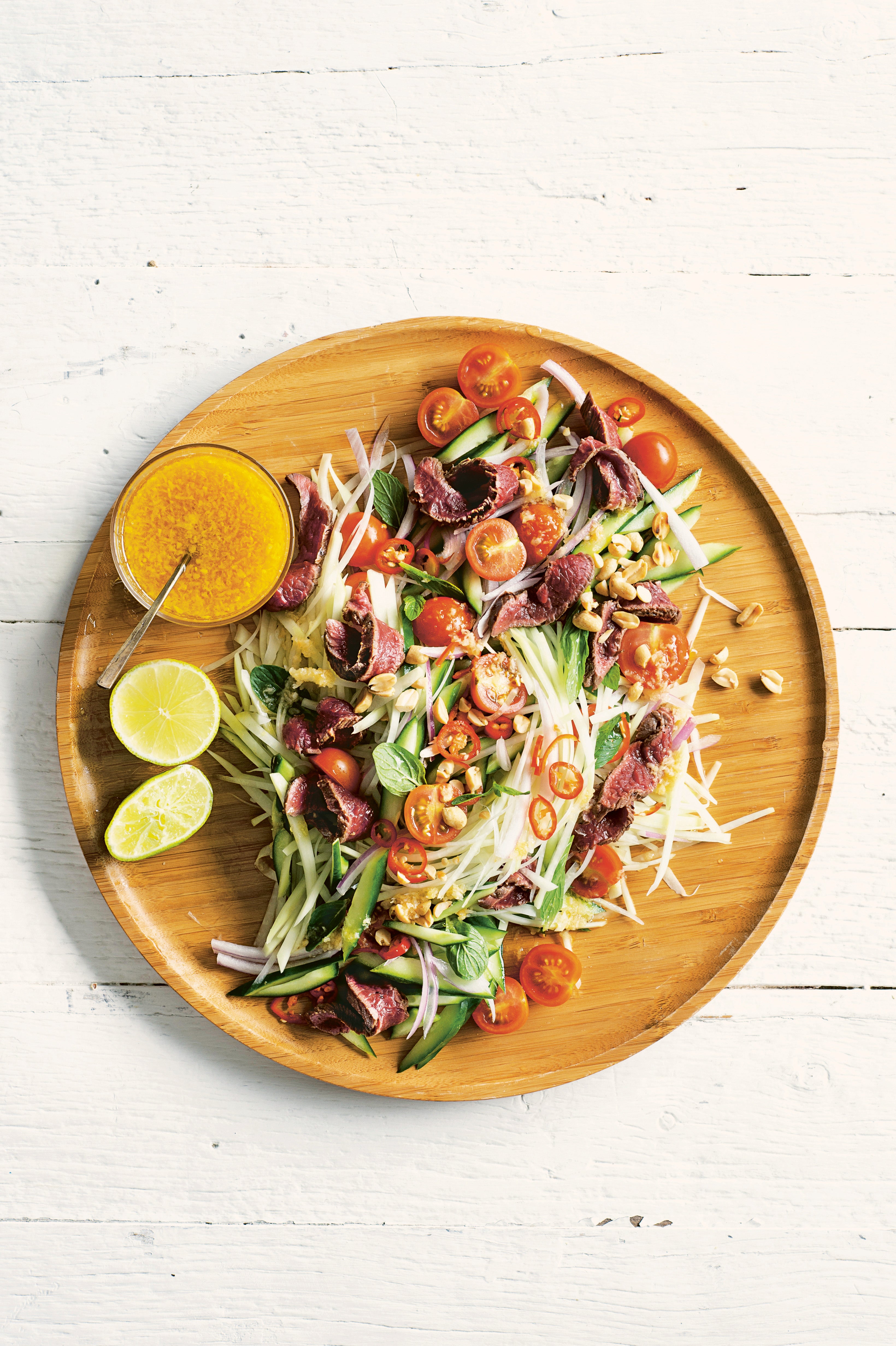
Australians on the whole are reluctant to eat kangaroo. Some do, most don’t… it is still hunted and cooked using traditional means by Australian First Peoples. According to the Australian Bureau of Statistics, and at the time of this book’s publication, 30 per cent of Australians were not born in Australia. This adds to the complexity in answering the simple question: “Why don’t more Australians eat kangaroo?”
Of all native animal meat, kangaroo would be the most popular and accessible. Other native species such as wallaby, emu, crocodile or magpie goose may appear, but on niche restaurant menus. The thing is, the kangaroo is part of our collective psyche. Indigenous and non-Indigenous alike. Aboriginal people have a diversity of views about kangaroo killing and the animal has myriad cultural, social and spiritual significances to the First Peoples. And First Peoples’ cultural practices govern sustainable consumption so that no species is ever over-hunted and its cultural significance is respected. The animal, along with the emu, is on the Australia coat of arms; it is on the dollar coin; and a much-loved children’s television show had as its star a kangaroo named Skippy. Need I say more?
Kangaroo is a very lean meat. Not only is it high in protein and low in saturated fats, but it tastes really good (it’s the perfect meat to throw on the barbecue) and is sold in just about any supermarket (grocery store). I think kangaroo meat is better than beef in this salad (beef is the meat that is typically used).
Preparation time: 30 minutes, plus 1-6 hours marinating
Cooking time: 6 minutes
Serves: 4
Ingredients
600g kangaroo fillet (tenderloin)
1tbsp fish sauce
1tbsp toasted sesame oil
2 cucumbers, seeds removed and finely sliced
1 red onion, very finely sliced
20g mint leaves
1 large red chilli, very finely sliced
1 small green papaya, finely shredded
300g cherry tomatoes, halved
50g roasted peanuts, coarsely chopped
1 lime, cut in half
For the dressing:
1tbsp olive oil
60ml (4tbsp) lime juice
60ml (4tbsp) fish sauce
2tsp granulated sugar
2 cloves garlic, crushed
3cm piece of fresh root ginger, peeled and finely grated
Method
To make the dressing, put all the ingredients into a small bowl and stir until the sugar has dissolved, then set aside.
Put the kangaroo into a bowl with the fish sauce and sesame oil and toss the meat around until it is coated all over in the marinade. Leave to marinate for up to 1 hour, or cover with clingfilm (plastic wrap) and refrigerate for up to 6 hours. If refrigerating, remove from the fridge 30 minutes before cooking.
Preheat the barbecue hotplate or a griddle pan to high. There is no need to oil the plate as the sesame oil in the marinade prevents the meat sticking. Cook the kangaroo for 3 minutes on each side. Remove to a plate and leave to rest for 10 minutes, then finely slice the meat across the grain. Place the meat in a large bowl and add the cucumbers, red onion, mint, chilli, papaya and tomatoes. Tumble the mixture onto a large serving plate. Pour over the dressing and sprinkle over the peanuts. Serve with the lime halves on the side to squeeze over.
Bugs with aioli
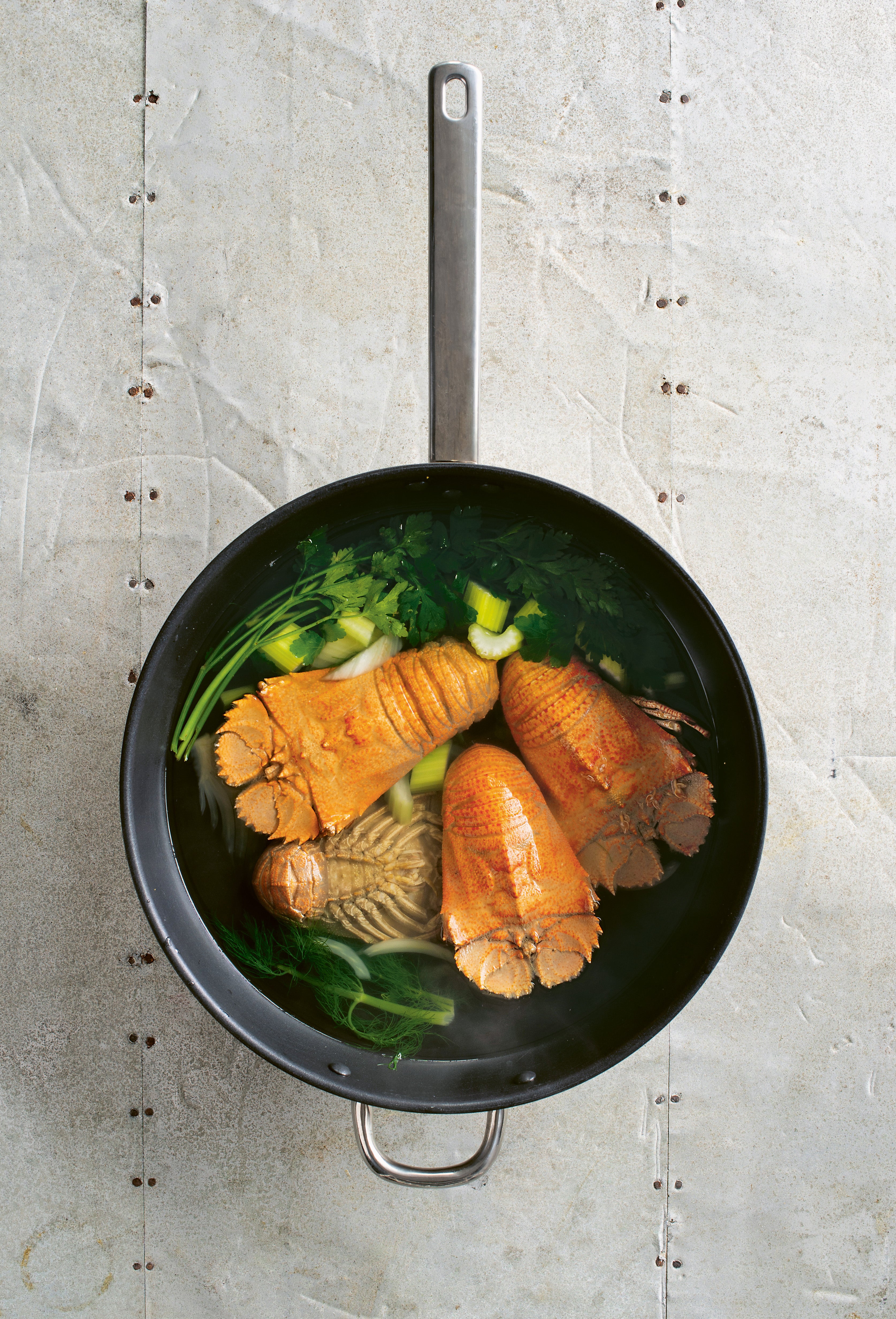
You read correctly. These unique crustaceans are native to the waters off the east coast of Australia. There are two types; Balmain or Moreton Bay. They are simply referred to as bugs. For a long time they were only ever eaten by the First Peoples and by immigrants from Europe, who came here in the 1950s. Almost everyone else thought they weren’t proper food. Not so now. Today, bugs are prized seafood and for good reason: the tail is filled with deliciously sweet meat. Some say they’re more luxe than lobster. I tend to agree. This is a simple way to prepare them and the same method can be used for yabbies, a fresh-water crustacean that is also native to inland streams, dams and rivers.
Preparation time: 15 minutes
Cooking time: 10 minutes, plus 5 minutes chilling
Serves: 4
Ingredients
2kg Balmain or Moreton Bay bugs (6-8 bugs)
1 large head fennel, preferably with fronds attached, coarsely chopped
2 stalks celery, coarsely chopped
Small bunch flat-leaf parsley
1tsp black peppercorns
Salt
To serve:
1 quantity aioli
Lemon wedges
Method
If the bugs are alive, put them into the freezer for 10-15 minutes or until they stop moving.
Bring a large pot of lightly salted water to the boil. As a guide, use 1 tablespoon salt to every 5 litres water. Add the fennel to the water with the celery, parsley and peppercorns and cook for 5 minutes to allow the flavours to develop. Add the bugs and stir them around. Cover the pan with a lid and cook for just 4-5 minutes, or until the bug shells turn a brighter shade of orange. In their natural state, they are a reddish-brown colour.
Fill a large bowl with iced water. Set aside. Use a slotted spoon to remove the bugs to the bowl of iced water. Leave the bugs in the iced water for 5 minutes, until completely chilled. Use a slotted spoon or tongs to remove the bugs and transfer them to a chopping (cutting) board, shaking off excess water. Turn the bugs over, so the back of the shell is on the chopping board. Use a large, sharp knife or a cleaver to cut each bug lengthwise down the centre. Arrange the bugs on a serving platter. Serve with a bowl of aioli and some lemon wedges on the side.
Australian-Chinese pork ribs
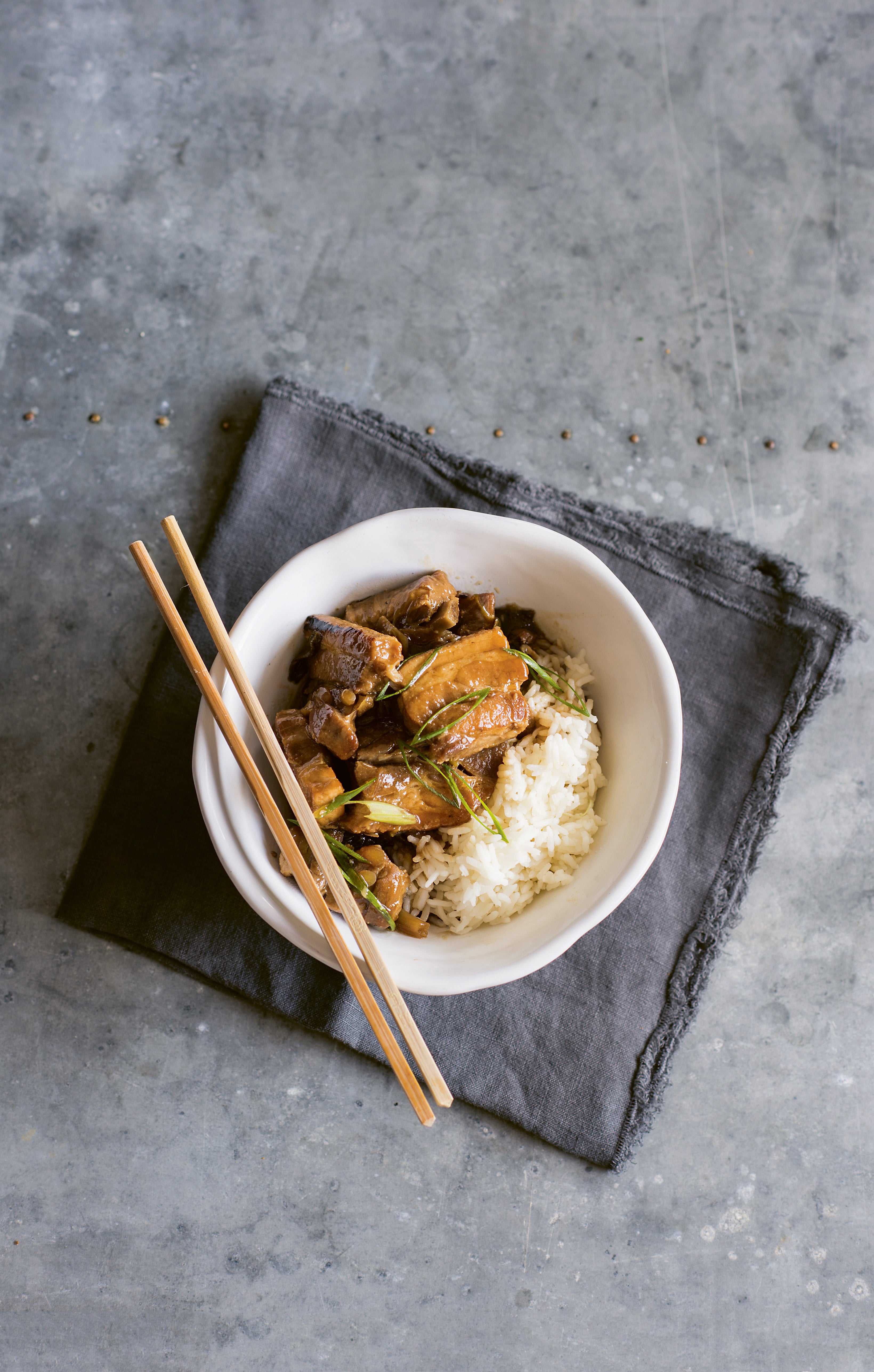
It was towards the end of working on this book that I was hit with the sad news that the doyenne of Australian cookery had passed away. The news of Margaret Fulton’s death was broadly felt across the community. All ages of people, from all walks of life, posted heartfelt and genuine comments about the impact that Margaret had on food in Australia. She introduced us to food from other places. I never met her but she struck me as fearless and a ground breaker. Her work really did pave the way for many of us “foodies”, domestic and commercial cooks alike. There was a demand for ingredients she used in her recipes. This meant that supermarkets had to stock previously unavailable ingredients. On the day of her passing, I heard a member of the Australian-Chinese community comment on the radio: “When Margaret Fulton cooked Chinese food, suddenly Sydney’s Chinatown had white people shopping there.” This recipe is inspired by one of Margaret’s early recipes.
Preparation time: 20 minutes
Cooking time: 1 hour 15 minutes
Serves: 4
Ingredients
1kg pork spare ribs, cut into 4-5cm
1tbsp rapeseed (canola) oil
3 cloves garlic, smashed and left whole
3cm piece of fresh root ginger, peeled and finely sliced
2 spring onions, white and green parts separated and finely sliced on the bias
50ml (3½tbsp) light soy sauce
50ml (3tbsp) Chinese rice wine
50ml (3tbsp) brown vinegar or Chinese black vinegar
2tbsp hoisin sauce
2tsp soft light brown sugar
Steamed rice, to serve
Method
Bring a large saucepan of water to the boil, add the pork and cook for 5 minutes. Drain well and set aside.
Heat the oil in an ovenproof casserole dish or Dutch oven over a high heat. Add the pork and cook for 4-5 minutes until golden. Stir through the garlic, ginger, white parts of the spring onions and cook for 1 minute. Add 500ml water, the soy sauce, rice wine, vinegar, hoisin sauce and sugar. Stir to combine and bring the mixture to the boil. Reduce the heat to low, so the mixture is gently simmering. Cover and cook for 1 hour. Remove the lid, increase the heat to high and bring to the boil. Cook for 8-10 minutes, until the sauce has thickened and the pork is very tender.
Serve in bowls with steamed rice and the finely sliced green parts of the spring onions scattered over the top.
Colonial goose
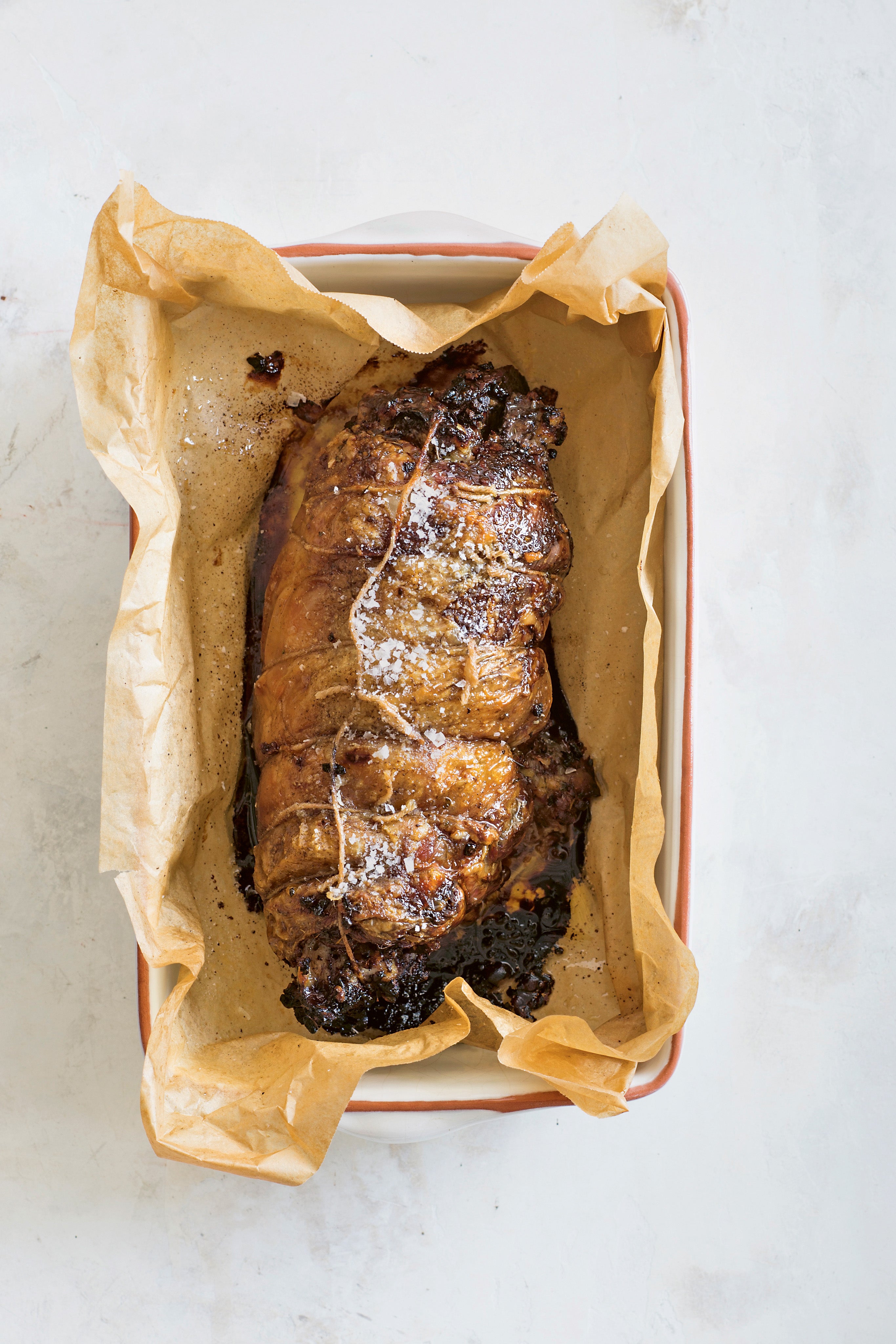
There was a desire driven by homesickness and nostalgia for British immigrants to replicate dishes from the Motherland. This also extended to the arts. Painting in particular was subject to a clash between old world technique and new world impressions. This attitude also blinded many of the colonisers to the culture of the First Peoples.
Even if ingredients weren’t on hand, faux versions were created. Goose was a popular item on the English Christmas table, so lamb became a substitute for goose. This was in vogue in Australia and New Zealand around the turn of the 20th century, and it kind of makes sense. Goose could not be found and mutton was readily available. The stuffing is typical of what would be used to stuff a goose at Christmas time in England. If offal isn’t your thing, you can always leave out the kidney, but there’s barely any in there, so you may not even notice it. It does, however, add an earthy flavour that is complemented by the sage.
You may, understandably, not choose to cook this at Christmas, in the heat of summer. It would, however, be an ideal addition to a “Christmas in July” dinner. These are becoming more popular across Australia as it provides the opportunity to cook and eat traditional Christmas fare in our winter. It is especially popular at hotels in the Blue Mountains, west of Sydney.
Preparation time: 20 minutes, plus 30 minutes resting
Cooking time: 1¾ hours
Serves: 8
Ingredients
1tbsp butter
2 rashers bacon, rind removed and finely chopped
1 onion, finely chopped
1 lamb kidney, finely chopped
60g fresh breadcrumbs
6 sage leaves, finely chopped
2tsp thyme leaves
2tbsp finely chopped curly parsley
1 x 2kg leg of lamb, deboned
1tbsp olive oil
Salt and pepper
To serve:
1tsp sea salt
1 quantity tomato and onion bake (page 70)
1 quantity mashed pumpkin (page 66)
Cooked peas
Method
To make the stuffing, heat the butter in a frying pan over a medium heat. Add the bacon and onion and cook for 3-4 minutes. Stir through the kidney and cook for another 2 minutes, or until the kidney is no longer pink. Transfer to a heatproof bowl and add the breadcrumbs and herbs. Season with salt and pepper and use your hands to mix so everything is thoroughly combined. Set aside.
Preheat the oven to 220C/425F/Gas Mark 7 and put a roasting pan into the oven.
Lay the lamb skin-side down on a clean work counter. Season the meat with salt and pepper, then sprinkle the stuffing over the centre of the meat, about 2cm from the edges. Roll the lamb up from the short end and tie the whole thing firmly with kitchen string so each tie is 3-4cm apart. Rub the oil all over the meat.
Place the lamb in the hot roasting pan, seam side down, and reduce the oven temperature to 180C/350F/Gas Mark 4. Cook for 1½ hours, until the lamb is well browned.
Remove the lamb from the oven and cover with aluminium foil. Leave to rest for 30 minutes before sprinkling with salt and carving. Serve with tomato and onion bake, mashed pumpkin and peas.
Neenish tarts
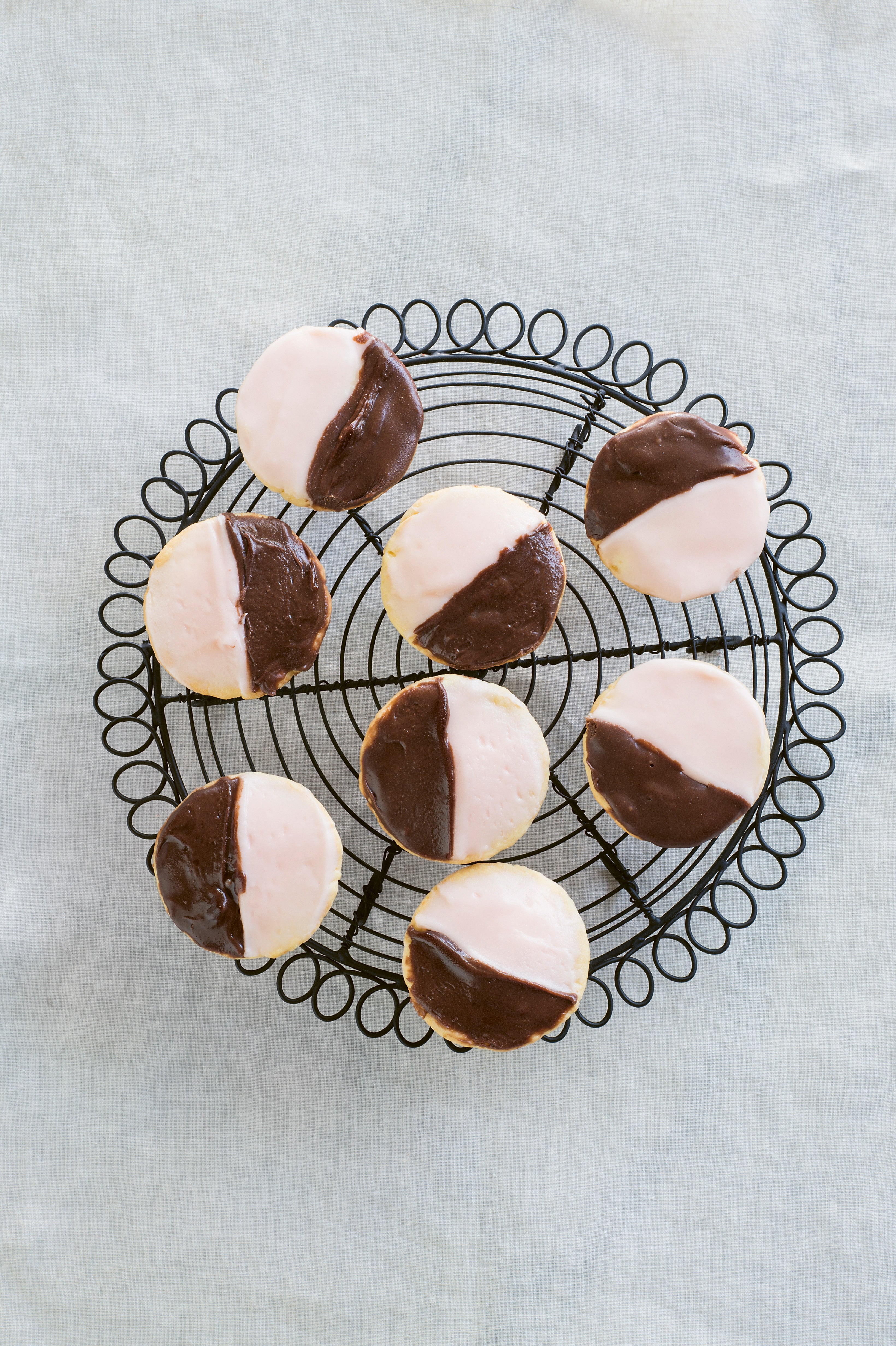
You wouldn’t be alone if you assumed these were British. They sound it, but these are, in fact, uniquely Australian. They have quadruple layers of sweetness. In order of appearance from bottom to top, the layers are: pastry, jam (jelly), mock cream, icing. There’s quite a bit going on here so you could be excused for using readymade shortcrust pastry instead of making your own. But you really do have to make your own mock cream and icing, and you may need to see a dentist immediately after eating one.
Preparation time: 30 minutes, plus at least 1 hour chilling
Cooking time: 20 minutes
Makes: 12 tarts
Ingredients
250ml raspberry jam
1 quantity Washed Mock Cream (page 383 in the book or you can find a recipe online)
For the pastry:
60g unsalted butter, plus extra for greasing
80g caster (superfine) sugar
1 egg
240g plain (all-purpose) flour, plus extra for dusting
2tsp baking powder
For the icing (frosting):
240g icing sugar
1tbsp unsalted butter, melted
2tbsp whole (full-fat) milk
1tsp cocoa powder
1-2 drops rose pink food colouring
Method
To make the pastry, preheat the oven to 180C/ 350F/Gas Mark 4. Lightly grease a 12 x 60-ml/ 2-fl oz-hole patty cake or 12-hole small muffin pan with butter. Set aside.
To make the pastry, put the butter and sugar into the bowl of a stand mixer fitted with a paddle attachment, or use hand-held electric beaters. Beat on medium speed for 4–5 minutes, scraping down the sides of the bowl a couple of times, to make a creamy mixture. Add the egg and beat for 1 minute. Scrape down the sides of the bowl. Reduce the speed to low and add the flour and baking powder. Add 2 tablespoons boiling water and beat for a minute or so until the mixture starts to clump together. Tip onto a lightly floured work counter and briefly knead to form into a smoothish ball. Don’t over-knead the dough. Cut the dough into 2 equal portions. This will make it easier to work with. Working with one portion at a time, roll out to a thickness of 3 mm/⅛ inch, then use a pastry cutter to cut out 6 x 9-cm/3½-inch circles. Repeat with the other piece of dough. Press the dough circles into the holes of the prepared pan. Sit a cupcake or small muffin paper case in each one and fill with baking beans (pie weights), then bake in the oven for 15 minutes. Remove the beans and papers and bake for another 2–3 minutes until golden. Remove from the pan and leave on a wire rack to cool completely.
Put the jam (jelly) into a saucepan and stir over a medium heat for 2–3 minutes until it can be spooned easily. Spoon the jam directly into the cooled pastry cases (shells). Set aside.
Make the mock cream, then put 1 tablespoon over the jam in the pastry cases. Use the back of a spoon to spread it evenly over the jam, then set aside.
To make the icing (frosting), sift the icing (confectioners’) sugar into a bowl. Put the butter and milk into a small saucepan and stir over a medium heat until the butter has just melted. Don’t allow it to boil. Use a balloon whisk to whisk the butter mixture into the sugar in the bowl until smooth. Pour about half the mixture into another small bowl. Stir the cocoa powder through one portion of the mixture and stir the pink food colouring into the other. Leave to stand for 5–10 minutes so it becomes less runny. Put about 1 teaspoon of the chocolate icing on one side of each tart and 1 teaspoon of the pink icing on the other. You can use the back of the spoon or a palette knife to spread, but the icing should settle and become smooth.
Transfer the tarts to a tray and refrigerate for at least 1 hour before serving.
‘Australia: The Cookbook’ by Ross Dobson is published by Phaidon, £35
Join our commenting forum
Join thought-provoking conversations, follow other Independent readers and see their replies
Comments